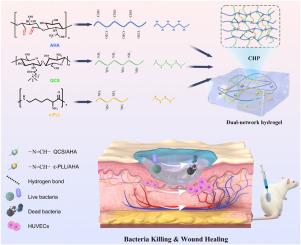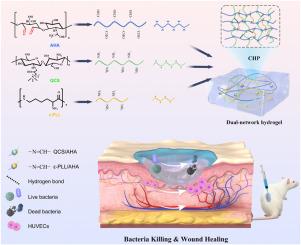可注射自愈双网壳聚糖/透明质酸/多肽(CHP)抗菌水凝胶用于伤口愈合
IF 4.5
2区 化学
Q2 POLYMER SCIENCE
引用次数: 0
摘要
皮肤伤口愈合面临细菌感染和环境刺激的挑战,因此具有抗菌和自愈能力的生物相容性伤口敷料的设计是有希望的。在此,我们报道了壳聚糖(CS)、透明质酸(HA)和多肽(PP)的生物活性复合水凝胶(CHP)的设计和合成。由于动态分子交联,制备的热电联产水凝胶具有良好的稳定性、良好的生物相容性、注射性、自愈能力和抗菌活性。微观分析表明,CHP水凝胶保持三维多孔双网络结构,水凝胶的孔隙率与PP作为补强剂的含量有关。抗菌评价表明,CHP水凝胶对大肠杆菌和金黄色葡萄球菌具有显著的抗菌效果,且PP浓度越高,效果越好。此外,水凝胶表现出增强的细胞相容性,最小的溶血,并改善体外细胞增殖。小鼠创伤模型实验表明,CHP水凝胶能有效促进创面愈合,促进血管生成,促进组织再生。组织学评估证实表皮再生完全,胶原沉积改善,蛋白表达增加。所设计的热电联产水凝胶作为一种伤口敷料具有潜在的临床应用价值,可以满足快速有效愈合伤口的需要。本文章由计算机程序翻译,如有差异,请以英文原文为准。


Injectable and self-healing dual-network chitosan/hyaluronic acid/polypeptide (CHP) antibacterial hydrogels for wound healing
Skin wound healing faces challenges of bacterial infection and environmental stimulation, and hence the design of biocompatible wound dressings with antibacterial and self-healing abilities is promising. Herein, we report the design and synthesis of bioactive composite hydrogels (CHP) with chitosan (CS), hyaluronic acid (HA), and polypeptide (PP). Ascribing to dynamic molecular cross-linking, the fabricated CHP hydrogels exhibit good stability, excellent biocompatibility, injectability, self-healing ability, and antimicrobial activity. Microscopic analysis indicates that the CHP hydrogels maintain a 3D porous dual-network structure, and the porosity of hydrogels is related to the content of PP as the reinforcement. Antimicrobial evaluation of the CHP hydrogels demonstrates significant efficacy against E. coli and S. aureus, with improved performance at higher PP concentration. Furthermore, the hydrogels show enhanced cytocompatibility, minimal hemolysis, and improved in vitro cell proliferation. The tests with wound mouse models indicate that the CHP hydrogels can accelerate wound healing effectively, enhance angiogenesis, and promote tissue regeneration. Histological evaluation confirms complete epidermal regeneration, improved collagen deposition, and increased protein expression. The designed CHP hydrogels present potential clinical applications as a wound dressing material to meet the needs of rapid and effective wound healing.
求助全文
通过发布文献求助,成功后即可免费获取论文全文。
去求助
来源期刊

Polymer
化学-高分子科学
CiteScore
7.90
自引率
8.70%
发文量
959
审稿时长
32 days
期刊介绍:
Polymer is an interdisciplinary journal dedicated to publishing innovative and significant advances in Polymer Physics, Chemistry and Technology. We welcome submissions on polymer hybrids, nanocomposites, characterisation and self-assembly. Polymer also publishes work on the technological application of polymers in energy and optoelectronics.
The main scope is covered but not limited to the following core areas:
Polymer Materials
Nanocomposites and hybrid nanomaterials
Polymer blends, films, fibres, networks and porous materials
Physical Characterization
Characterisation, modelling and simulation* of molecular and materials properties in bulk, solution, and thin films
Polymer Engineering
Advanced multiscale processing methods
Polymer Synthesis, Modification and Self-assembly
Including designer polymer architectures, mechanisms and kinetics, and supramolecular polymerization
Technological Applications
Polymers for energy generation and storage
Polymer membranes for separation technology
Polymers for opto- and microelectronics.
 求助内容:
求助内容: 应助结果提醒方式:
应助结果提醒方式:


